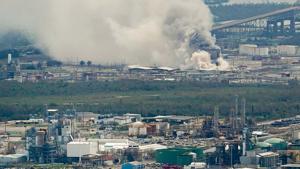
A United Nations panel released its sixth assessment report on climate change in March, a culmination of years of research and the efforts of hundreds of scientists.
The full 85-page report can be read online at the Intergovernmental Panel on Climate Change website, but the main takeaways are consistent with what most of the world’s scientists have been saying for years now: The Earth is warming because of human activity.
“Human activities, principally through emissions of greenhouse gasses, have unequivocally caused global warming, with global surface temperature reaching 1.1°C above 1850–1900 in 2011–2020,” the report reads.
The panel has stressed the importance of remaining below 1.5°C of warming above pre-industrial levels to avoid the most devastating impacts of climate change.
Now just 0.4°C from that marker, the panel reported the ways in which “human-caused climate change is already affecting many weather and climate extremes in every region across the globe.”
The panel reports with a level of “very high confidence” that “there is a rapidly closing window of opportunity to secure a livable and sustainable future for all.”
For coastal communities like those in southern Louisiana, that warning is dire.
Louisiana’s climate vulnerability
The effects of climate change have already been felt in Louisiana, especially along the coast.
Louisiana has lost 2,000 square miles of land—a mass the size of Delaware—from the coast since the 1930s. Rising seas are one factor that worsen that creeping coastline.
“Louisiana’s coast has two problems: One is sea level rise caused by climate change, and one is the sinking of Louisiana’s coast caused by a number of other factors, the most notable of which is the leveeing of the Mississippi River,” said Brian Snyder, an associate professor in LSU’s department of environmental sciences. “The Mississippi River didn’t used to have levees. We built those levees to keep the river from flooding, and when we did that, it reduced the amount of sediment that gets input to the marshes, so those marshes are eroding and sinking.”
The future without action is alarming for south Louisiana.
“In most of the scenarios that I’ve seen, the worst-case scenario is the ocean being right around the Baton Rouge and Ascension Parish border,” Snyder said. That would turn Baton Rouge into a coastal city and anything south of it all but unlivable.
Louisiana’s coast could rise over 4 feet by 2100, according to a 2022 report from the National Oceanic and Atmospheric Administration and NASA.
But Louisiana has a vision to address its land loss problem.
It’s called the Coastal Master Plan, set forth by the Louisiana Coastal Protection and Restoration Authority and approved by the state legislature to counteract the sinking coast.
The most recent edition of the plan calls for $50 billion worth of investment in protecting the coast, and, if successful, could help build back lost land.
However, anything much after 2050 is difficult to determine, for the latter half of the 21st century is when sea levels begin to play a bigger part in the welfare of the coast, and the plan is only working on a 50-year timeframe, stopping its predictions around the year 2060.
“While we do not know exactly how the coast will change in coming decades, the fact is that the coast will certainly be different than it is today, just as it is different now than in the past,” the plan reads. “The master plan’s intent is not to halt or reverse that change, but rather to use advanced tools to anticipate a range of possible future outcomes. These predictions provide a basis for a plan that moves toward more desirable and sustainable outcomes for Louisiana residents, businesses, and our natural coastal resources.”
Extreme weather is another battle Louisiana is fighting on the climate front.
Scientists project climate change will increase the rainfall and wind speeds of hurricanes, according to the National Oceanic and Atmospheric Administration.
That projection is worrying for a state like Louisiana, which in the 2020 and 2021 hurricane seasons saw hundreds of thousands of power outages, billions of dollars in damage and thousands of people displaced from their homes.
What’s humanity’s next step?
Though the world’s scientists issued a dire warning to humanity in the U.N. panel’s latest climate report, they also say that urgent action to protect the future is still in reach.
“Changes in the food sector, electricity, transport, industry, buildings and land-use can reduce greenhouse gas emissions” and make people healthier, the IPCC’s press release read.
The IPCC’s guide for policymakers said that public and private money still flows more toward fossil fuels than climate adaptation and mitigation.
All the technology and solutions needed to reduce greenhouse gas emissions are already available, according to the U.N. panel. But, the scientists say, governments must act with urgency to move toward cleaner energy and away from fossil fuels.
How the world moves forward in addressing rising sea levels will impact billions of people around the world—including those residing along Louisiana’s coast.


Leave a Reply